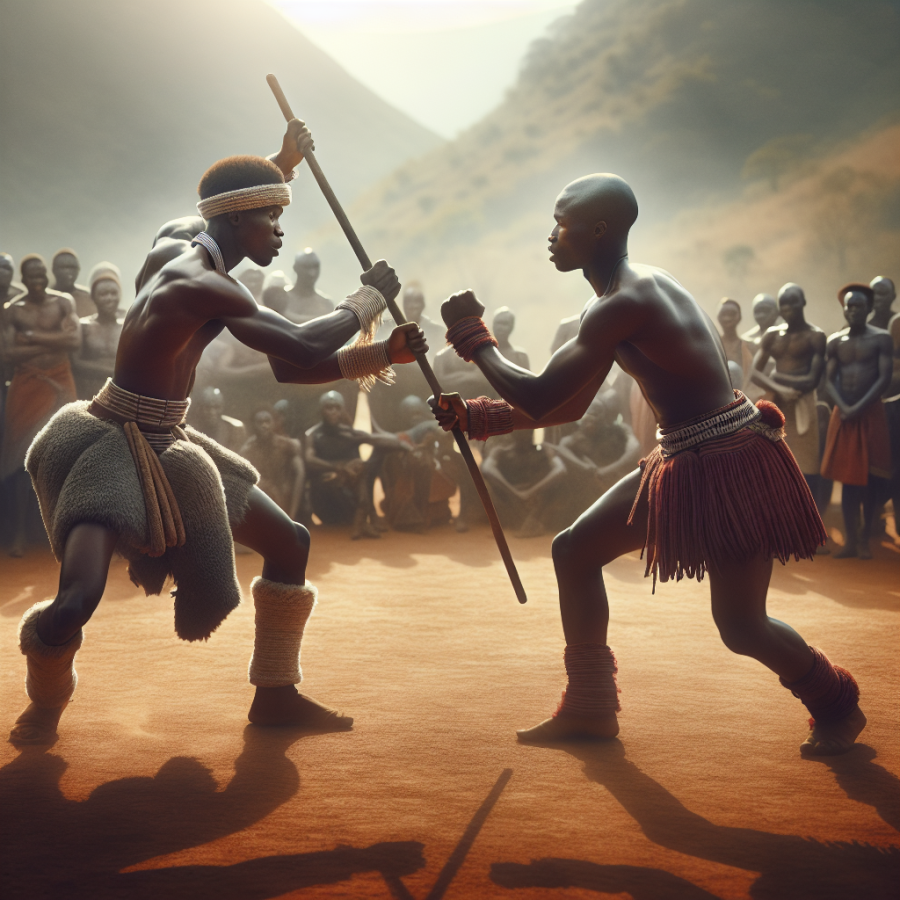The Intricacies of Nguni Stick-Fighting: Techniques and Traditions
Nguni stick-fighting, a martial art deeply entrenched in the South African warrior traditions, is a skill that has been passed down through generations. At first glance, it might seem like a simple form of combat, but the intricacies of this fighting style reveal a complex blend of technique, physical coordination, and cultural significance.
At the core of Nguni stick-fighting is the use of two sticks—one defensive and the other offensive. The longer stick, typically measuring about four to five feet in length, is used to strike and attack, while the shorter stick, known as the isihlangu, serves defensively to block and parry incoming blows. A small shield can sometimes supplement this shorter stick, offering additional protection.
Mastering the techniques of Nguni stick-fighting requires a profound understanding of both offensive and defensive movements. Skilled fighters demonstrate an impressive display of agility and precision. Attacks are not random; they follow a strategic pattern aimed at specific points of the opponent's body, and seasoned fighters can execute feints and deceptive strikes to outmaneuver their adversaries.
Defense maneuvers in Nguni stick-fighting are as crucial as offensive techniques. The ability to anticipate an opponent's next move and respond with an immediate and effective block is a hallmark of expertise in this martial art. Successful defense often relies on quick footwork, enabling the defender to maintain balance and readiness to counterattack.
Traditionally, Nguni stick-fighting was more than just a fighting technique—it was a rite of passage for young men. Through stick-fighting, they developed physical strength, mental resilience, and learned the values of courage and discipline. The activity also served as a way to resolve conflicts within and between communities, where combatants would engage in a regulated duel under the watchful eye of experienced elders who ensured that the rules were adhered to.
Moreover, the tradition of Nguni stick-fighting is steeped in ritual. Fighters often prepare for combat through various cultural practices, including the use of traditional attire, war cries, and pre-fight dances that serve to intimidate opponents and to bolster the morale of the fighters. Songs and chants accompany these dances, creating an atmosphere of competition and camaraderie.
Despite its deeply rooted traditions, Nguni stick-fighting is not static. It has evolved over time, incorporating influences from other martial arts and adapting to the changing social context of modern South Africa.
Read also:
Soaring on Sheer Muscle: The Quest for Human-Powered Flight
Preserving the Legacy: The Cultural Significance of Stick-Fighting in Nguni Societies
The cultural significance of stick-fighting within Nguni societies is profound, extending far beyond mere physical combat. This traditional martial art, deeply rooted in the history and identity of the Nguni people, has served not only as a method of self-defense but also as a means of socialization, education, and preserving community values.
Stick-fighting was historically a way for young Nguni men to prove their valor, enhance their reputations, and prepare for the rigors of adulthood and warfare. It also played a critical role in the rites of passage ceremonies, which marked the transition from youth to manhood. During these ceremonies, the display of stick-fighting prowess was a crucial component, as it showcased the agility, strength, and combat skills of the participants.
Within the complex social fabric of Nguni societies, stick-fighting embedded social norms and values, as it delineated acceptable forms of competition and conflict resolution. Elders and community leaders often supervised these contests, ensuring that they adhered to the codes of conduct that emphasized honor, bravery, and fair play. These regulated bouts were a form of communication—a dialogue facilitated through the clashing of sticks—articulating social relationships, reinforcing communal bonds, and resolving interpersonal tensions.
Furthermore, the art of stick-fighting was interwoven with spiritual beliefs. The sticks used in these combats were not merely weapons; they were imbued with symbolic importance and sometimes believed to possess ancestral spirits. The fighters would perform rituals before engaging in a bout, invoking the blessings of their ancestors for protection and victory. These spiritual dimensions of stick-fighting highlight how the practice transcends the physical realm and connects participants to the metaphysical aspects of their culture.
In the context of a constantly changing and modernizing South Africa, preserving the tradition of Nguni stick-fighting is a matter of cultural resilience. While the practice may no longer be as central to Nguni life as it once was, efforts to maintain it serve as a conduit for transmitting historical wisdom and cultural pride to new generations. Stick-fighting continues to be a potent symbol of Nguni heritage, a tangible link to a past that informs the present and will influence the future shaping of these communities.
Nowadays, amidst fears that globalization and technology might erode indigenous customs, there has been a resurgent interest in promoting and preserving stick-fighting. Cultural festivals, educational programs, and competitive events all play roles in ensuring the vibrancy and continuity of this martial art.




